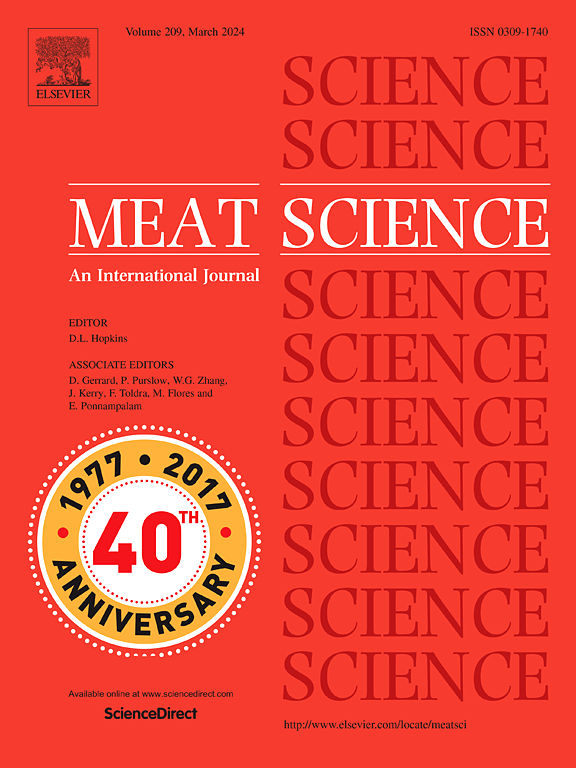Infrared thermography of beef carcasses and random forest algorithm to predict temperature and pH of Longissimus thoracis on carcasses
IF 6.1
1区 农林科学
Q1 Agricultural and Biological Sciences
引用次数: 0
Abstract
This study aimed to evaluate the use of infrared thermography (IRT) as a method for predicting the initial and ultimate temperature, as well as the pH, of the Longissimus thoracis in beef carcasses (LTBC). A total of 102 beef carcasses, consisting of 62 F1 Red Angus × Nelore and 40 Nelore cattle, approximately 14 months of age, were evaluated before and after refrigeration. Temperature and pH values of the LTBC were measured using a probe thermometer and a pH meter. To predict these parameters, IRT was used to measure surface temperature features of the fore, hind, and Longissimus thoracis regions, as well as the whole carcass. The Random Forest machine learning algorithm was applied for predictive modeling. The results of this study indicated that it was possible to use IRT to predict temperature of LTBC with R2 values ranging from 0.06 to 0.78 and MAE from 1.12 to 1.67. For initial temperature was R2 of 0.06 and ultimate temperature with R2 values 0.26 and 0.17. The inclusion of hot carcass weight (HCW) parameter improved the prediction of ultimate temperature with an R2 from 0.78 to 0.86. The prediction of LTBC pH with thermal images showed R2 values ranging from 0.26 to 0.82 and MAE from 0.10 to 0.82. The combination of IRT and HCW improved the prediction of muscle ultimate pH in the carcass. In conclusion, the IRT method can predict the initial and ultimate pH and temperature of LTBC, with improved accuracy when combined with the HCW parameter.
牛肉尸体的红外热成像和随机森林算法预测尸体上胸最长肌的温度和pH值
本研究旨在评估红外热像仪(IRT)作为预测牛肉胴体(LTBC)胸最长肌初始和最终温度以及pH值的方法。总共102具牛肉尸体,包括62头F1 Red Angus × Nelore牛和40头Nelore牛,大约14个月龄,在冷藏前后进行了评估。使用探针温度计和pH计测量LTBC的温度和pH值。为了预测这些参数,使用IRT测量前、后、胸最长肌区域以及整个胴体的表面温度特征。采用随机森林机器学习算法进行预测建模。本研究结果表明,IRT可以预测LTBC的温度,R2为0.06 ~ 0.78,MAE为1.12 ~ 1.67。初始温度的R2为0.06,最终温度的R2为0.26和0.17。加入热胴体重(HCW)参数后,对极限温度的预测R2由0.78提高到0.86。热图像预测LTBC pH的R2值为0.26 ~ 0.82,MAE值为0.10 ~ 0.82。IRT和HCW联合使用提高了对胴体肌肉最终pH值的预测。综上所述,IRT方法可以预测LTBC的初始和最终pH和温度,并且与HCW参数相结合可以提高准确性。
本文章由计算机程序翻译,如有差异,请以英文原文为准。
求助全文
约1分钟内获得全文
求助全文
来源期刊

Meat Science
工程技术-食品科技
CiteScore
12.60
自引率
9.90%
发文量
282
审稿时长
60 days
期刊介绍:
The aim of Meat Science is to serve as a suitable platform for the dissemination of interdisciplinary and international knowledge on all factors influencing the properties of meat. While the journal primarily focuses on the flesh of mammals, contributions related to poultry will be considered if they enhance the overall understanding of the relationship between muscle nature and meat quality post mortem. Additionally, papers on large birds (e.g., emus, ostriches) as well as wild-captured mammals and crocodiles will be welcomed.
 求助内容:
求助内容: 应助结果提醒方式:
应助结果提醒方式:


